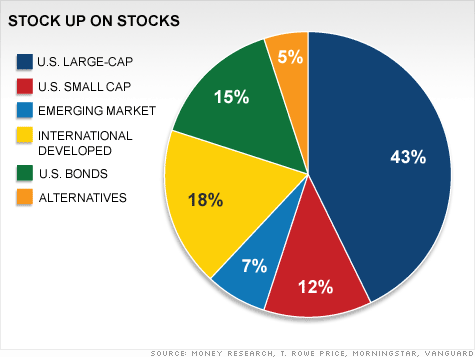Search News

How should you divvy up your investments in your late 30s and early 40s? Try this model portfolio.
(MONEY Magazine) -- When it comes to putting together a retirement portfolio, you need to think like an athlete running a marathon.
The race isn't always easy. No doubt you'll experience periods in which the market puts you to the test, whether in the form of raging bears like those of 2000 and 2008 or the jolting volatility that's come with the climb back from the financial crisis.
What you need is a long-term strategy that will help you stay the course and finish strong.
That starts with a diversified "core" of investments. From there, as you age, you'll make shifts that take into account your changing financial stamina.
Here is the first of three model portfolios plus suggestions for investments -- including low-cost funds from the MONEY 70. This one will carry you from age 35 to 44. You can also check out our investing tips for ages 45 to 54 and 55-plus.
Want to exercise more muscle? Choose the "boost" option, which involves taking a bit more risk for the chance at more return.
Even without this extra pop, though, the strong core you'll find here will help you reach retirement a winner.
Go for major growth. By your mid-thirties, you've likely accumulated some real money. Time to start getting serious about how you invest those savings.
In this first stage you want to build in lots of potential for growth. So 70% to 80% of your money should be in stocks, divvied among U.S. companies large and small, and foreign companies in both emerging and developed markets. Index funds are the name of the game.
"They'll give you the broadest foundation," says Fran Kinniry, a principal in Vanguard's investment strategy group.
The following MONEY 70 index funds will provide ample diversification and growth potential for your early years:
U.S. stocks: Put 43% into large caps, 12% into small caps. Schwab S&P 500 Index (SWPPX) and Vanguard Small-Cap Index (NAESX): Today it's possible to invest in one index fund or ETF and get exposure to nearly every U.S. stock. But you'll lose control over how much money goes into small companies, which have potential for higher growth. To be more deliberate, go with separate large- and small-cap funds.
International stocks: 18%. Fidelity Spartan International Index (FSIIX) and Vanguard Emerging Markets Stock Index (VEIEX): These two funds invest in developed and emerging markets, respectively. Since foreign stocks make up roughly half the world equity market cap, they shouldn't be ignored. Still, planners advise against keeping more than 30% of your stock slice abroad, since such equities have drawbacks, including currency risk.
U.S. bonds: 15%. Vanguard Total Bond Market Index (VBMFX): Because you don't yet have a big fixed-income stake, you want a fund with wide exposure to high-quality U.S. bonds.
Alternatives: 5%. Cohen & Steers Realty Shares (CSRSX): Real estate doesn't usually move in lockstep with stocks or bonds. Thus REITs can diversify your mix. The group has gotten pricey, though, so rather than an index, go for Cohen & Steers; the fund's managers have a good record of finding value.
Over the past 20 years, stocks of midsize companies -- those with market values of $2 billion to $18 billion -- have returned 11% annually, trumping large (8%) and small firms (9%).
You already own some midcaps via your U.S. stock funds, but a bigger share may give you more growth -- though with extra risk, since midcaps are more volatile than large companies.
OK with that? Cut your large-cap holding from 43% to 38%, and invest the difference in stocks or a fund like these:
Midcap stocks: 5%. Signet Jewelers (SIG): As competitors folded in the recession, the retailer won market share, says Dennis Bryan, co-portfolio manager of FPA Capital. Earnings are expected to expand 12% annually over the next five years.
Energy XXI (EXXI): The oil and gas exploration firm will grow production capacity 20% year-over-year and as of early March was set to test another reserve. "That could be a catalyst for the stock," says Matthew Kaufler, co-manager of Federated Clover Value.
Midcap fund. FPA Perennial (FPPFX): The fund buys leading small and mid-size companies that have strong balance sheets and are selling at a discount.
Best investments for every age:
Ages 35 to 44: Going for major growth
Ages 45 to 54: Cushioning the core
Do you know a Money Hero? MONEY magazine is celebrating people, both famous and unsung, who have done extraordinary work to improve others' financial well-being. Nominate your Money Hero. ![]()
| Overnight Avg Rate | Latest | Change | Last Week |
|---|---|---|---|
| 30 yr fixed | 3.80% | 3.88% | |
| 15 yr fixed | 3.20% | 3.23% | |
| 5/1 ARM | 3.84% | 3.88% | |
| 30 yr refi | 3.82% | 3.93% | |
| 15 yr refi | 3.20% | 3.23% |
Today's featured rates: